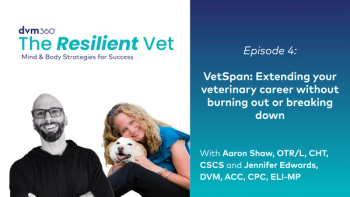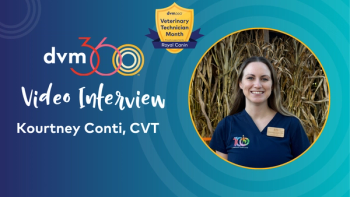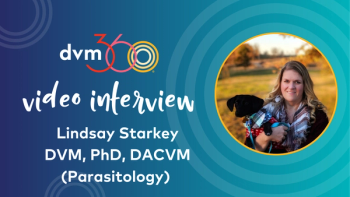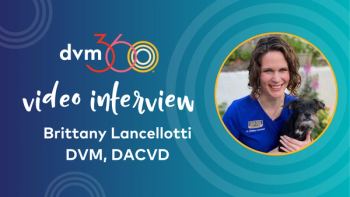
Smaller dogs have an increased incidence of periodontal disease, explains Heidi Lobprise, DVM, DAVDC, a veterinary dental specialist.

Smaller dogs have an increased incidence of periodontal disease, explains Heidi Lobprise, DVM, DAVDC, a veterinary dental specialist.

Monica Tarantino, DVM, MBA, highlights the importance of proactive chronic pain management in elderly dogs.

Heidi Lobprise, DVM, DAVDC, shares practical tips and easy-to-use tools to protect soft tissues and improve safety during extractions, in this interview with dvm360.

Cynthia M. Otto, DVM, PhD, DACVECC, DACVSMR, explains what competing techniques the research team looked at and how they can further this research.

Veterinary dental expert Heidi Lobprise, DVM, DAVDC, shares her technique for extracting an upper fourth premolar, in this interview with dvm360.

Otto breaks down the physiology and field data behind the head dunk technique and why active cooling is preferable to passive rest in hot conditions.

Jack Teitelman, CEO and founder of TITAN Group, shares key takeaways from his New York Vet Show session on DEA compliance.

Megan Shepherd, DVM, PhD, DACVIM (Nutrition), shares how yeast-based probiotics offer unique advantages over traditional bacteria-based options.

The top cause is periodontal disease, explains Heidi Lobprise, DVM, DAVDC.

Real resilience starts with understanding what matters most to you, explain Aaron Shaw, OTR/L, CHT, CSCS, and Jennifer Edwards, DVM, ACC, CPC, ELI-MP.

Understanding where a client is on the spectrum of concern regarding their pet’s quality of life is essential, explains Monica Tarantino, DVM, MBA, in this interview at the 2025 New York Vet Show.

Galina Hayes, BVSc, DVSc, PhD, DACVECC, DACVS, discusses how to adapt the surgical technique when challenges arise.

Signs of pain may be subtle and be mistaken for old age, explains Monica Tarantino, DVM, MBA, in an interview at the 2025 New York Vet Show.

A simple interrupted pattern and a simple continuous pattern are most commonly used, but how do you decide which one to use? Galina Hayes, BVSc, DVSc, PhD, DACVECC, DACVS, offers an answer.

Galina Hayes, BVSc, DVSc, PhD, DACVECC, DACVS, talks about the biggest physiologic factor that influences how the intestine heals after surgery in this dvm360 interview.

Learn how to protect the career you love—and your physical and emotional well-being—through VetSpan™.

Kourtney Conti, CVT, discusses her role as a member of the veterinary team at Elmwood Park Zoo in Pennsylvania.

Explore how AI is transforming veterinary education on this episode of Vet Watch.

Craig Clifford, DVM, MS, DACVIM (Oncology), and Christine Mullin, VMD, DACVIM (Oncology), discuss the logistics and implications of immunotherapy treatments for canine oncology patients.

Brian J. Sutherland, DVM, DACVS-SA, shares the differences between palliative procedures and definitive procedures in this interview with dvm360

During an interview with dvm360, Lindsay Starkey, DVM, PhD, DACVM (Parasitology) shares multiple vector-borne diseases and infections that can be presenting in feline patients

Karen Kline, DVM, MS, DACVIM (Neurology), shares common anticonvulsants for patients with seizures, and offers advice for veterinarians conducting a neurologic examination

Christopher Shapley, DVM, CVA, CVCH, CVFT, talks about his multimodal approach for dogs with certain neurological diseases, and why it works

Christopher Shapley, DVM, CVA, CVCH, CVFT, explains what veterinary acupuncture is, and why it’s useful

Craig A Clifford, DVM, MS, DACVIM (Oncology), talks about the general practitioner’s role in the care for patients with cancer

In interview with dvm360, Brittany Lancellotti, DVM, DACVD , shares what the remission of itch is, and what it means for patients

Jennifer Sheahan, DVM, DACVO, shares the common ocular conditions that general practitioners can be on the lookout for in their clinic

Christopher Pachel, DVM, DACVB, CABC, talks about essentials that should be covered with clients during their first puppy appointment

Joya Griffin, DVM, DACVD, shared common challenges veterinarians face when diagnosing felines with allergic diseases

Andrew Rosenberg, DVM, DACVD, shares the complexities of diagnosing and treating feline dermatology conditions, and how to make it easier for teams and clients.